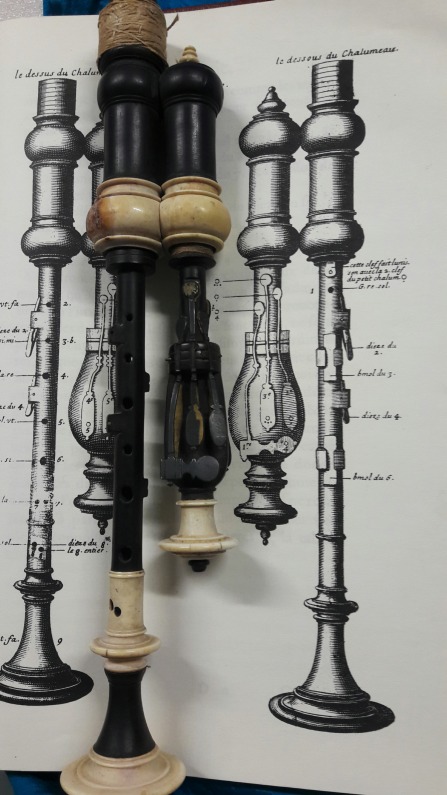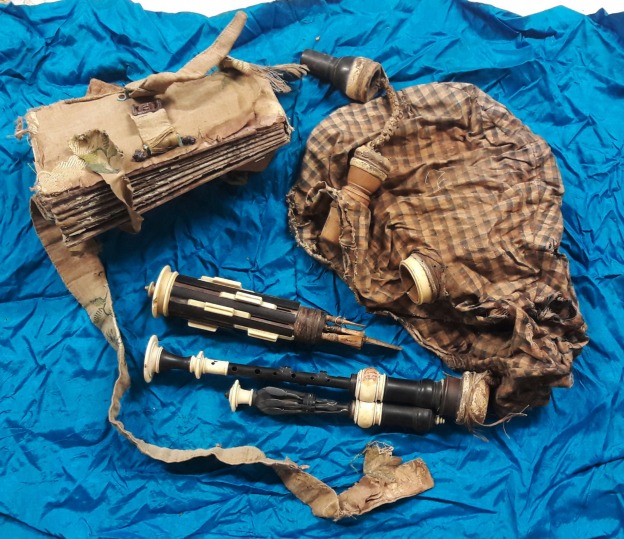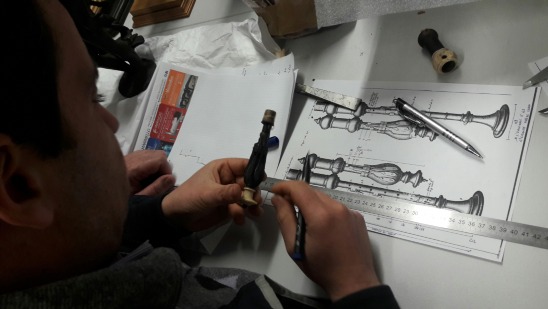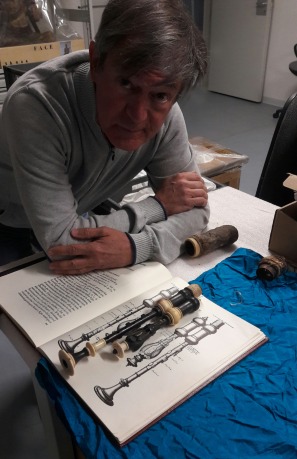The Bagpipe Society
The Musette de Cour from the Calvet Museum in Avignon
The recreation of a complex instrument as seen from a luthier’s point of view.
The “Musette de Cour” that I had the honour to recreate is an old, original specimen and is presently kept at the Calvet Museum in Avignon and was probably made by Martin Hotteterre at the end of the 17th century.
Eric Montbel invited me to work with him on this ambitious project as he had seen in me a luthier who was prepared to take on the recreation of such a complex instrument. I enthusiastically accepted this challenge as I was able to rely on his precious and valuable contribution both as musician an expert on bagpipes. It was thanks to Eric that the Calvet museum allowed me to study and measure such a delicate and precious object, worthy a place in a collection of masterpieces.
The measurement took place under the supervision of three museum representatives. It was a memorable day of hard work, in company of Eric and Giogio Pinai, and I was certainly under pressure as I was conscious I had to complete the detailed design of the instrument in just a few hours and I would not be given a second chance to examine the instrument.
I first listened to the Musette de Cour in 2004, when Jean Pierre Van Hees came to Italy to work on a publication about bagpipes and, after a visit to my workshop, he wanted to include an entire chapter on the Zampogna Gigante. The Zampogna Gigante, as the name suggests, is a big instrument, almost two meters high. It is a difficult instrument to make and its use has died out over the last century. The Museum delle Arti e Tradizioni Popolari in Rome allowed me to measure their surviving example and I have now been able to bring back to life an instrument which only survived in the memory and in the many historical examples which still exist.
The sound of the Musette played by Jean Pierre struck me with its sweetness and stylistic elegance. Jean Pierre invited me to play it and it created a strong emotion for me. His advice and tips have been essential in giving me an understanding of the original method of the Musette and therefore the ability to re-create the instrument. Nevertheless, it was in Avignon, when I had the opportunity to observe every single part of the instrument, that I realised that I had a real masterpiece in front of me.

The Musette de Cour in Avignon is made out of ebony and ivory. The instrument seems identical to the one pictured in a book published in 1672, Traîté De la Musette by Borjon de Scelery, possibly representing the original, kept at the museum. After the first inspection, I noticed that all the Grand Chalumeau metal keys were missing except for one, from which I could derive the type of construction and the shape of the missing ones. They are linear, very simple, without decoration but functional. Some of the keys supports in wood were also torn. The Petit Chalumeau seems to have been made at a later date, the keys are finely decorated, as faithfully reported in the drawing. A different artist has presumably made the keys, or at least the artist did not want them to go unnoticed.
All the reeds are original and are still in a good state of preservation. From the reeds, I could infer useful information which allowed me to reconstruct the instrument as it was intended and played back in the XVII century. The small evidences of wear indicate that the Musette de Cour de Avignon belonged to a musician and not to a collector.

Le Grand Chalumeau: The Grand Chalumeau is made in two parts with a detachable bell and five keys, normally closed. It is tuned at 392 Hz. Borjon’s drawing shows double holes for both G and A while the original instrument has double holes only for G and a single hole for A. In fact, a detailed observation of the drawing actually shows that the A hole seems to have been amended and modified at a later stage. During the measurement I noticed - from my perspective as an instrument maker – some interesting characteristics of the instrument:
-
the chanter reed is remarkably bigger than the reed commonly used for bagpipes. It is absolutely identical to the one used for the oldest Italian Zampogna, the Zampogna Zoppa, a double chanter instrument widespread in Italy in the XVII century.
-
the tonality of the Musette coincides with the one of the Zampogna Zoppa.
-
the lower notes of Musette chanter are played with the same finger as Zampogna Zoppa and despite being considerably smaller, the Musette plays the same note in the same octave of Zampogna and not sharper/ higher as one would expect.
-
In fact, the Musette is the expression of pastoral refined music in France and this could justify the similarities with zampogna, the pastoral instrument par excellence of Italy. The smooth soft sound and the staccato sensation differentiate the Musette de Cour from Zampogna Zoppa, clearly separating the environment in which they were found.
The Petit Chalumeau: Le Petit Chalumeau is a short-stopped chanter with six keys, normally closed and it produces a sound only when a hole is opened or a key is pressed. The tone holes are positioned on a little cylindrical support, only 10 mm diameter, bowed in the central part and terminating with a small closed bell. The original Musettes from 18th century, instead are realized with a bigger cylindrical support with two flat parts on opposite sides.
The Avignon Musette keys are curved at the top, as they need to close the holes that are radially set on the external circumference of the support. This fact creates an increased difficulty in opening and closing the holes as they are not in line with the keys. In later instruments, holes are drilled on the flat part and in line with the keys.
The internal bore of the Petit Chalumeau has a smaller cross section, the tone holes are placed in the upper part and are situated close to each other over a few centimetres, with a length of the air column of few centimetres. The keys easily interfere with each other: and it is easy to press two keys at the same time by mistake. Probably for this reason, in later instruments, the manufacture of the key was simplified in favour of a shape that allows for more distance between them. The keys’ springs are fixed on the wood part and not to the keys themselves as was the case with later types.
Drones: The most amazing thing has been discovering the functioning of the drones. In a finely turned wood cylinder of 32 mm of diameter there are inserted 6 drones. These 6 drones are supplied by u-shaped narrow channels variously connected that have ascending and descending parts. In total there are 16 internal cylindrical bores placed on two circular crowns, 12 on the outer crown and four on the inner one. At the top of the wooden cylindrical block are fixed 6 reeds, the bigger one is pertaining to the bass drone and the remaining 5 pertaining to the other drones, all of them being of the same dimensions. Fitting 16 internal cylindrical bores in a 12 mm radius must surely have been a great challenge for the inventor of the instrument, the reeds are so close that they must be assembled and disassembled following a precise sequencing and utilizing a single possible position.
The shuttles should guarantee a hermetic seal when they are closed, in order to avoid air leaks but at the same time they should not exercise too much resistance in order to allow a precise tuning. The shuttles are finely carved in ivory, with a heart shaped cross section, the precision with which the shuttle slides in its casing underline the extraordinary ability of the luthier and the level of accuracy he obtained.

If the shuttle is set too “hard”, then the musician needs to excerpt more power which would prevent small adjustments which will have affect fine tuning. On the other hand, a low pressure will not give a constant stability to the shuttle and that will risk compromising the intonation of the drone or it will leak air when closed producing unwanted notes. In addition, the drone of the Musette of Avignon is made from wood and that suffers from changes in humidity much more than ivory. Moreover, the drone strongly suffers from moisture variations due to the bellows.
In a mouth-blown bagpipe the humidity variations are lower than when compared to the ones of a bellows blown instrument because the players, by blowing in the bag, supplies the instrument with a constant amount of humid air. On a particularly dry day the bagpipe will be dry at the beginning, but whilst being played it will progressively gain humidity to reach a balance, and consequently the wood will stabilize, no matter what the external humidity is.
In a bellows-blown instrument, the wood humidity degree will depend only on the external air humidity, because the air that is inside in not the humid breath of the player. On a particularly dry day the bagpipe will be fed with dry air and consequently its humidity rate will be very low, whilst on a humid day also the wood also becomes humid as the instrument is played. The result is that the instrument will tend to expand on humid days and shrink on dry days, without finding a stable balance. As a consequence, the shuttle and drone also will tend to expand and shrink and therefore the coupling will sometime be tight and some other times it will become loose. This phenomenon happens most in changeable climatic environments. For this reason, at the base of the shuttle casing there is set a string of animal skin that will in part counterbalance, with its own modifications, the modifications of wood and shuttle.
The precision of the perfect link between the drone and the shuttle, made by hand and with few simple tools, leaves one speechless.
The n°1 drone has a very big reed, fixed on a bore whose section is wider than the bore of the other 5 drones, internal air channels are articulated in 6 linear segments and five u curves, the total length is thus 6 times longer than the entire cylinder. On the drone external surface, the first two outlets enable two different notes - G and F.
Drones 2, 3 and 4 have reeds and internal bores of the same dimension, the internal air channels are articulated in 2 linear segments and 1 u curve. Every drone has an outlet on the second segment of the internal bore low part; the n°4 has a second outlet on the second part of the bore. The shuttle of drone 2 and 3 closes the outlet when it is in the low position and opens them when it is positioned at the top (it is in the upright position) to produce the D note. With drone 4, one can also obtain the F note. In fact, the shuttle closes the two outlets when it is put in the central position. If the shuttle slides in the upper part it produces the D note while closing the upper outlet. If the shuttle slides downward it closes progressively the outlet at the bottom and when the latter is completely closed it opens the upper outlet the F note. The shuttle opens the upper outlet downwards, in a direction that does not allow it to extend the air column. In my opinion, the non-adjustable note maybe the diapason note.
Drone n° 5 has a reed with the same dimensions as the others, internal air channels are articulated in 2 linear segments and 1 u curve. Also, this drone has an outlet in the top part of the second segment that open or closes the F note without the possibility of tuning it, its closing position is upward.
Drone n°6 also has a reed with the same dimensions as the others and internal air channels articulated in 2 linear segments and 1 u-curve. The outlet instead is positioned on the first segment, before the u-curve and it is connected with the second segment, creating an air by-pass between the two segments. In this way the drone sounds the G note. Supposedly the by-pass has been realized to modify the originally drone note.
Difficulties: We can affirm that the Musette de Cour is a fascinating instrument, beautiful to see and delightful to listen to. The proportions and external features are equally important as its fascinating sound. This has forced the maker to identify technical solutions that would exploit the musical potential without affecting its appearance.
As I normally work on much bigger instruments, I had to carefully adapt manufacturing processes and techniques to make them fit for such a minute and complex instrument. This difficulty, which at first hindered my work, helped me understand that I was creating an instrument that was used in a context by far distant from the type of popular music instruments that I usually make. Indeed, the sound of the Musette should not be similar to that of the other bagpipes.
The double reeds, usually utilized on conical bore, have quite a different acoustic behaviour when utilized on the cylindrical bore of the Musette. For this reason, I had to dedicate much time to the construction of reeds. The fact that the instrument is bellows-blown also added complexity to the process of making the cane reeds function properly. Miniature keys have also been an important obstacle as, owing to their small size, their proper functioning is very delicate.
Le Petit Chalumeau is much longer than the air column it has to excite, because the keys need to be operated by the left-hand pinkie and by the right-hand thumb, that are in an set position in relation to the holes of the Grand Chalumeau while playing. The Petit Chalumeau should be positioned in such a way as to allow the performer to play the two chanters with the fingers of the same hand. The keys’ reciprocal distance should be precisely calculated: not too small in order to operated them easily without the risk to open two holes at the same time, not excessive that would oblige too ample fingers movements.
The drones are situated by the player’s chest and each of them should be positioned in such a way to be accessible for tuning. Ideally, the instrument should be able to maintain 8 reeds at the same time while guaranteeing a stable sound.

Shuttles are positioned at equidistant intervals on the outer surface and consequently the bores of the bass drone are positioned in the same way. The internal bores that constitute the first drone, having a bigger diameter, are closer to each other and are separated by a thin 1mm wooden partition. This means that drilling the drone is an extremely delicate operation with no margin of error.
Bearing in mind that the Musette had been made in a pre-industrialised era, when technology offered no more than a simple foot-powered lathe and a bunch of handmade tools, we can fully appreciate how competent and passionate the “luthier” was that first created it.
Rebuilding this complex instrument has been a true challenge for me, a challenge that I have faced with great passion. Labours, doubts and failed attempts have been fully repaid by the successful conclusion, when I could hear the magical sound of the newly reconstructed Musette.
I’m delighted to have faithfully replicated the Avignon original, one of the oldest surviving examples of a Musette de Cour with two chalumeaux, that has defied time and has preserved in a condition where it could supply all information needed for its reconstruction. For all of these above-mentioned reasons, the Musette can really be considered a masterpiece of art and engineering.
All photos : Eric Montbel and Giorgio Pinai.
- Data Processing Notice (GDPR)
@BagpipeSociety on X (formally known as Twitter)
TheBagpipeSociety on Instagram
 BagpipeSociety on Facebook
BagpipeSociety on Facebook
Something wrong or missing from this page? Let us know!
